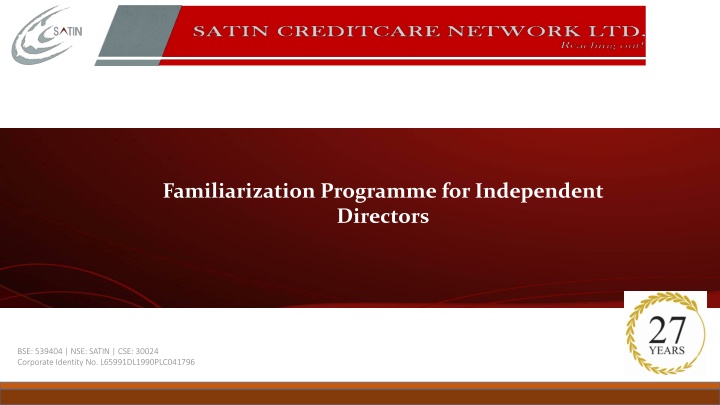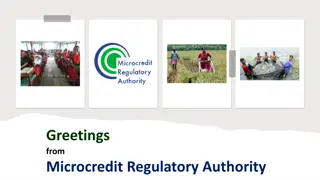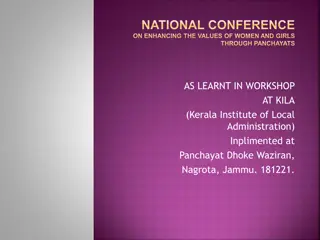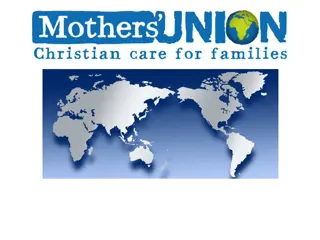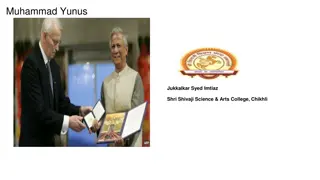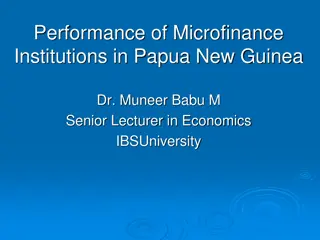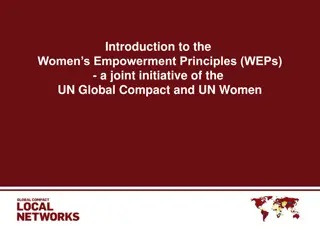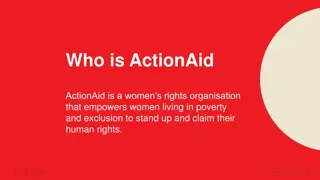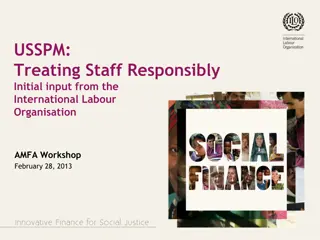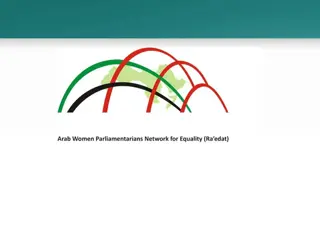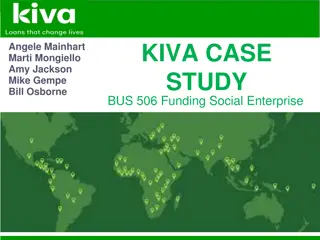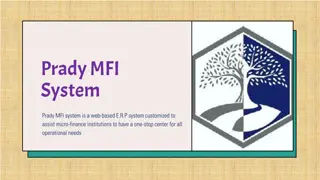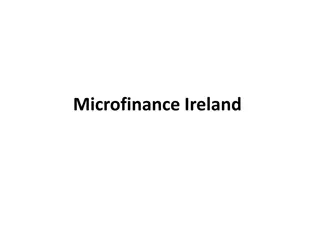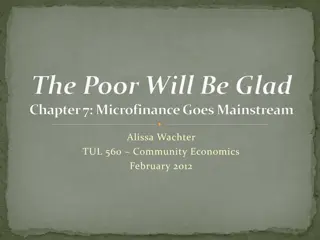Microfinance: Empowering Women for Sustainable Development
Microfinance plays a crucial role in providing financial services to low-income individuals, especially women, to help improve their standard of living and empower them economically. Through microfinance initiatives, women are given the opportunity to enhance their financial responsibility, contribute to household income, and drive social change. This approach not only benefits women directly but also has positive ripple effects on their families and communities. By focusing on women-centric sustainable development, microfinance programs aim to address poverty, promote financial inclusion, and create a more equitable society.
Download Presentation

Please find below an Image/Link to download the presentation.
The content on the website is provided AS IS for your information and personal use only. It may not be sold, licensed, or shared on other websites without obtaining consent from the author.If you encounter any issues during the download, it is possible that the publisher has removed the file from their server.
You are allowed to download the files provided on this website for personal or commercial use, subject to the condition that they are used lawfully. All files are the property of their respective owners.
The content on the website is provided AS IS for your information and personal use only. It may not be sold, licensed, or shared on other websites without obtaining consent from the author.
E N D
Presentation Transcript
Familiarization Programme for Independent Directors BSE: 539404 | NSE: SATIN | CSE: 30024 Corporate Identity No. L65991DL1990PLC041796
Microfinance Through Window of Relevance Micro-finance is defined as financial services such as savings, insurance, fund, credit etc., provided to poor and low income clients in rural, semi-urban or urban areas so as to help them raise their income levels, thereby improving their standard of living . Banks Institutional Reliability Multi-product Low branch penetration Design constraint Assurance of timely credit MFI Poverty Increased income and saving Risk Doorstep service No collateral Small ticket loans only Mitigation (Insurance) Illiteracy Impact of MFI SHGs and Co-Ops Closest institutions Collateral Substitutes Scale up constraint Limited credit Trust Deficit (Formal FIs) Moneylenders Improved Literacy Convenience Very high interest rates Attached collateral Exploitative Empowerment 2
Demand for Micro-Credit in India About 220 mn Households and USD 44 bn market size NBFC-MFIs + SFBs+ Non profit MFIs = USD 10 bn, as of Mar 17 Rich 2 Mn ~220 mn households in the poor to middle income category Assuming that even 50% of the households can be financially supported Potential market size assuming basic lending at ~USD 400 per HH An estimated market opportunity of USD 44 billion High Income 53 Mn HHs Middle Income 80 Mn HHs Micro Finance Customer base Low Income 84 Mn HHs Poor 56 Mn HHs Average monthly income of Households (HHs) in USD: Rich ~1,450; High Income 460; Middle Income ~200; Low Income ~115; Poor is less than USD 55 per month 3
Women-Centric Sustainable Development : Microfinance Women constitute the core fabric of microfinance and are also the critical success factor Women are often among the most vulnerable and poorest members of low-income societies Financially Responsible & More Reliable Improved Sustainability High in Social Collateral 70% of the world s poor are women Microfinance is a powerful instrument of social change, particularly for women Influence children s nutrition, health, and education Controlled Household Income Obvious economic and social benefits to involving women in microfinance programs Work for Betterment of Entire Family Women are the family nucleus, that is vital for societal improvement and progress
Evolution of SCNL Reaches 2.65 mn(A) active clients and gross AUM of Rs.40,665.98 mn(A) as on Mar 17 Satin raises USD 10 mn from ADB making this ADB s first direct equity investment in a NBFC-MFI in India Raised Rs. 2.50 bn via QIP in Oct 16 CARE Ratings upgraded LT Bank Facilities & NCDs to A- in Oct 16 Acquired TSL in Sep 16 Exit of DMP in Jul'16 and Shore Capital in Aug 16 Started MSME Lending in FY17 Reaches 0.17 mn active clients and gross AUM of Rs. 1,690.76 mn as on Mar 10 Raised Rs. 25.08 mn from Lok Capital in Nov 10 and Rs. 218.50 mn from ShoreCap II in Dec 10 Rs. 77.50 mn infused by Promoter Group 2017 Starts SHG bank linkage program in Rewa, MP Receives 83% in microfinance COCA audit - 2016 2015 2014 2013 Received Client Protection Certificate under the Smart Campaign 2016 from M-CRIL Received Best Micro Finance Company in India from Worldwide Achievers Registers as NBFC with the RBI Raised Rs. 19.42 mn from Lok Capital 2011 2012 Date of inception of Satin on October 16, 1990 2008 Listing on NSE, BSE and CSE Raised Rs. 414.70 mn from SBI FMO (including warrants) Rs. 378.30 mn infused by Promoter Group Received top MFI grading of MFI 1 2010 2009 1996 1998 Receives MIX Social Performance Reporting Award at Silver level Raised Rs. 180.50 mn from DMP in Feb 11 1990 Reaches 0.80 mn active clients and gross AUM of Rs. 10,560.55mn as on Mar 14 Raised floating rate long term unsecured Tier II debt in Jul 14 Raised Rs. 284.37 mn of equity from NMI and USD 10 mn of debt from World Business Capital in the form of ECB Reaches 0.49 million active clients and gross AUM of Rs. 5,800.26 mn as on Mar 13 Converts to NBFC-MFI in Nov 13 Received MFI 2+ rating by CARE (second highest on an eight point scale) Raised Rs. 300.00 mn from DMP, Shore Capital and Micro Vest Rs. 110.00 mn infused by Promoter Group Exit of Lok Capital First private equity investment -- Raised Rs. 48.74 mn from Lok Capital Started JLG Model Rs. 10.00 mn infused by Promoter Group IPO and listing on DSE, JSE and LSE 5
SCNLs Product Portfolio SCNL s vision is to offer a complete suite of financial services to the bottom of the pyramid SCNL Gross AUM % - Mar 2017 JLG based Microfinance MSME 1% Business Corresponde nt 11% MSME Other 11% SCNL Agri / Allied Activities 43% Production 5% Product Financing Solar, Water & Sanitation Service/ Trade 29% Business Correspondent Subsidiary Housing Finance - Subsidiary 6
SCNLs Model of Microfinance SCNL has adopted the Joint Liability Group (JLG) Model for microfinance Disbursement and Repayment Post KYC check and Credit Bureau check, loans are disbursed to each of the members belonging to a particular Centre On specific repayment dates Centre members come together to repay the amount due Centre Formation 3-5 such Groups come together to form a Centre Hence a Centre has 12-30 members A Centre Leader is chosen All members of a Centre are jointly liable to repay on behalf of defaulting members Group Formation 4-6 women come together to form a homogeneous group Formed on the basis of Social Collateral A Group Leader is chosen from amongst the group members 7
Field Operation Process: SCNL 3. Group formation with GL & CL 1. Village Survey & Village Selection 2. Open General Meeting (OGM) 5. Raising Credit Bureau Enquiry 4. KYC collection & giving loan acknowledgement form to members 6. House visit by CSO 7. Compulsory Group Training (CGT) 8. Group Recognition Test (GRT) & House verification 10. Approving Loan Application 11. Date & time of center meeting is communicated to member 8
Impact and Achievements of SCNL Sustainable Social Impact on Clients Dedicated Client Support : SPARSH Operational Effectiveness: --Robustness of process --Experienced and professional field team Self Assessment: Dedicated Social Audit to measure our social performance
Awards for SCNL Winner of Best NBFC-MFI Award & Runner-up for CSR Initiatives & Business Responsibility Award in NBFC-MFI category CIMSME Banking and NBFC Awards 2016 Received certificate for being the Best Micro Finance Company in India from Worldwide Achievers at the Business Leaders Summit and Awards, 2016 Received Client Protection Certificate under the Smart Campaign 2016 from M-CRIL Received India Iconic Name in Microfinance Award- 2015 from IIBA First MFI to receive funding from Mudra Bank 10
SCNL at a Glance Gross Lending Portfolio (USD Mn) No. of Branches 767 626 503 36,168** 431 329 267 162 199 163 161 144 97 89 49 35 26 FY10 FY11 FY12 FY13 FY14 FY15 FY16 FY17 FY10 FY11 FY12 FY13 FY14 FY15 FY16 FY17 No. of Villages Number of Clients (Mn) 33,631 34,173 2.65 1.85 22,499 1.19 16,135 0.80 0.49 11945 0.31 8888 0.25 7773 0.17 4013 FY10 FY11 FY12 FY13 FY14 FY15 FY16 FY17 FY10 FY11 FY12 FY13 FY14 FY15 FY16 FY17 11
Business Trend: MFI Vs. SCNL (Contd..) 120% Market share by Gross AUM, as of FY17 % YoY Growth in GLP 103% 102% 100% 82% Belstar 1% RGVN 1% 80% SVCL 2% 61% 53% 60% 43% Other 11% Madura 2% 40% 25% 20% JFS 27% Fusion 2% 11% 0% Arohan 2% FY14 FY15 FY16 FY17 All MFIs SCNL (Standalone) Sonata 2% % YoY Growth in Active Clients 70% 64% Annapur 55% 60% 49% 50% Spandana 3% 44% 40% 29% 30% Disha 3% 30% 24% 22% BFIL 20% 20% Asirvad 4% Grameen Koota 7% 10% SCNL 8% Muthoot Microfin 4% 0% FY14 FY15 FY16 FY17 NBFC-MFI Industry AUM of Rs. 46,847 Crore as of March 2017 All MFIs SCNL (Standalone) 12
Business Trend: MFI Vs. SCNL (Contd..) Average Loan Outstanding, as of Mar 2017 (Rs.) 25,764 21,313 21,206 18,823 17,187 16,891 15,970 15,277 14,917 15,009 14,807 14,071 13,768 14,588 12,332 11,600 11,275 Average Loan Disbursed, as of Mar 2017 (Rs.) 33,299 27,329 25,433 24,597 24,345 23,196 24,453 21,779 21,214 21,025 20,674 20,527 20,164 18,676 17,779 16,639 10,887 13
Business Trend: MFI Vs. SCNL Growth in business trend (Loan Accounts) in Lakhs 109% 120% 100% 75% 80% 60% 49% 48% 60% 33% 40% 23% 23% 22% 22% 20% 0% Total (all MFIs) MFIs (glp < Rs 100 Cr.) MFIs (glp > Rs 100-500 Cr.) MFIs (glp > Rs 500 Cr.) SCNL % change in FY 15-16 over FY 14-15 (yoy) % change in FY 16-17 over FY 15-16 (yoy) Growth in business trend (Gross Loan Portfolio) in Rs. Crore 200% 163% 150% 113% 102% 101% 100% 53% 33% 25% 50% 24% 13% 11% 0% Total (all MFIs) MFIs (glp < Rs 100 Cr.) MFIs (glp > Rs 100-500 Cr.) MFIs (glp > Rs 500 Cr.) SCNL % change in FY 15-16 over FY 14-15 (yoy) % change in FY 16-17 over FY 15-16 (yoy) 14
Going Ahead! Full scale bank - Complete range of credit/saving/remittance & insurance service provider - Group lending technology to be replicated through institutional development service across the world - Synthesizing business logic through related diversification in SME space - Preferred financial service provider Beyond 5 years - 5 million customers - USD 5 billion asset - Small bank - Institutional lending - Remittance services 3-5 years - USD 1.8 billion assets - BC for many banks - SME financing - Employer of Choice Current Position 15
Thank You!! Thank You!! 16
